
History of First the World Telugu Conferences
In 1975 the then Government of Andhra Pradesh organized the First World Telugu Conference, with the objectives of bringing togetherthe Telugus that are spread all over the world on to one common plat form and make them understand the views of one another, become aware of the greatness of their Telugu language, culture, history, ancestry of their arts, improve their friendly relations and strengthen the ties between India and other nations In the earlier year, i.e., in 1974, State level Telugu Conferences were held at Nizam College grounds in Hyderabad. Drawing inspiration from this, the First Telugu Conferences were held on a grand scale at the LalBahadur Stadium in Hyderabad from 12th (the auspicious Ugadi festival day) to 18th April 1975. The venue of this Conference was named as Kakatiya Nagar. It is estimated that nearly a lakh of people attended the conferences each day. Delegate-teams from different countries across the globe had attended the Conferences. Prominent people that include writers, scholars, litterateurs, artistes, political leaders, freedom fighters, intellectuals. film personalities, educationists, scientists, journalists and others participated in these Conferences.
SEMINARS:
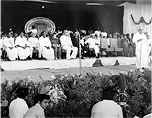 The premises where Seminars were held at this venue was named as "NAGARJUNA PEETHAM'. Daily meetings were held on different topics for 8 hours a day from 9.00 a.m. in the morning to 1.00 p.m., and from 2.00 p.m. to 6.00 p.m., in the afternoon, running to 40 hours in all. Thorough discussions were held on 28 topics that include language, literature, history, culture, science and technology. Nearly 100 papers were presented by the participants and more than 1500 participated in these Seminars.
The premises where Seminars were held at this venue was named as "NAGARJUNA PEETHAM'. Daily meetings were held on different topics for 8 hours a day from 9.00 a.m. in the morning to 1.00 p.m., and from 2.00 p.m. to 6.00 p.m., in the afternoon, running to 40 hours in all. Thorough discussions were held on 28 topics that include language, literature, history, culture, science and technology. Nearly 100 papers were presented by the participants and more than 1500 participated in these Seminars.
SEMINARS:

CULTURAL PROGRAMMES:
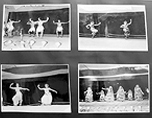 At the 'SRI KRISHNA DEVARAYA DARBAR' located in the Kakatiya Nagar , daily cultural programmes were held for 10 hours a day from 6.00 p.m., to pre-dawn morning. In all, 100 cultural programmes were presented with daily performances numbering from 10 to 13. Music, dance, Stage, folk art forms, Harikatha, Burrakatha performances were presented by both internationally reputed artistes and budding performers. More than 2 lakh audience witnessed these programmes each day
At the 'SRI KRISHNA DEVARAYA DARBAR' located in the Kakatiya Nagar , daily cultural programmes were held for 10 hours a day from 6.00 p.m., to pre-dawn morning. In all, 100 cultural programmes were presented with daily performances numbering from 10 to 13. Music, dance, Stage, folk art forms, Harikatha, Burrakatha performances were presented by both internationally reputed artistes and budding performers. More than 2 lakh audience witnessed these programmes each day
MUSEUM:
A Museum called "TARATARĀLA TELUGU JĀTI" was organized at the SATAVAHANA NAGAR. The two and half a thousand year old history of the Telugus is exhibited in this exhibition. There were 53 oil paintings, 240 black and white photographs, 29 charts, 40 pictures of the Nagarjuna Hills, 10 Maps, 6 pot paintings, 8 ancient royal seals, a model of the Amaravati Stupa and many attractive exhibits were shown in this exhibition.
FELICITATIONS:
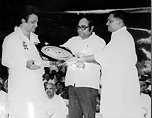 As a part of the celebrations, 239 national and international Telugu luminaries were honoured in the presence of lakhs of participants. Each luminary was presented with a memento with the Conference symbol, Shawl, Monograph, Souvenir, brief Case etc.
As a part of the celebrations, 239 national and international Telugu luminaries were honoured in the presence of lakhs of participants. Each luminary was presented with a memento with the Conference symbol, Shawl, Monograph, Souvenir, brief Case etc.
DELEGATES:
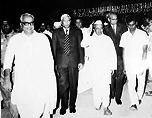 These conferences were attended by 92 observers and delegates from 16 countries. 981 delegates came from other states and 4,489 delegates from different districts in the State had attended. The delegate fee was Rs.25. The Government of India and the A.P.State Road Transport Corporation provided concession in travel fares for the delegates and observers.
These conferences were attended by 92 observers and delegates from 16 countries. 981 delegates came from other states and 4,489 delegates from different districts in the State had attended. The delegate fee was Rs.25. The Government of India and the A.P.State Road Transport Corporation provided concession in travel fares for the delegates and observers.
PROCESSION:
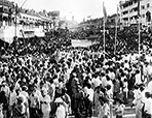 On the first day after noon at 12.00 noon, a procession was started from Charminar and proceed to the venue of the Conferences by evening under the leadership of the then Chief Minister Sri JalagamVengalaRao. Ministers, members of Parliament and State Assembly, representative of different organizations, officials, non-officials, men, women, youth, boys, girls and others participated in large numbers. The special attraction of the procession was the showering of flowers on the procession by the helicopter from above, creating a joyous scene.
On the first day after noon at 12.00 noon, a procession was started from Charminar and proceed to the venue of the Conferences by evening under the leadership of the then Chief Minister Sri JalagamVengalaRao. Ministers, members of Parliament and State Assembly, representative of different organizations, officials, non-officials, men, women, youth, boys, girls and others participated in large numbers. The special attraction of the procession was the showering of flowers on the procession by the helicopter from above, creating a joyous scene.

MUSEUM:
A Museum called "TARATARĀLA TELUGU JĀTI" was organized at the SATAVAHANA NAGAR. The two and half a thousand year old history of the Telugus is exhibited in this exhibition. There were 53 oil paintings, 240 black and white photographs, 29 charts, 40 pictures of the Nagarjuna Hills, 10 Maps, 6 pot paintings, 8 ancient royal seals, a model of the Amaravati Stupa and many attractive exhibits were shown in this exhibition.
FELICITATIONS:

DELEGATES:

PROCESSION:

THE INAGURAL FUNCTION:
The Conferences were started with the singing of the prayer, "Mā Telugu TallikiMalle Poo Danda" by KumTanguturiSuryakumari, who had come all the way from London to sing the prayer.
PUBLICATIONS:
Nearly 78 monographs on different subjects like Telugu language and literature, history, culture etc., were published during the Conferences. The responsibility of printing these monographs was taken up and organized by the then Sahitya, Sangeeta, Nataka, Lalitakala, and Science Academies
SPECIAL SOUVENIR:
Souvenirs were published in Telugu, Hindi, English and Urdu languages with articles written by eminent scholars on subjects that reflect the complete history of the Telugus over ages.
SUPPORT FROM CENTRAL GOVERNMENT:
Besides providing concessions in railway fares, the Government of India sanctioned an amount of Rs.1.00 for the Conferences and also released a special postal stamp to mark the occasion.
FILM SHOWS:
During the course of the Conference, 47 specially selected best Telugu films were freely screened in different theatres for the benefit of the participating delegates.
FUNDS:
The then Telugu film artistes of Chennai had presented cultural programmes at 8 places and collected a sum of Rs. 13.76 lakhs and gave it as contribution ot the Conferences. COMMITTEES
The Government appointed a Steering Committee, an Executive Committee, 22 sub-committees and a co-ordination committee for the sub committees to smooth conduct of the conferences.
The Government also appointed regional committees in cities like Chennai, Bengaluru, Mumbai, Nagpur, New Delhi etc.the year 1975 was declared as 'Telugu cultural year'.The Government further directed all the institutions in the State that in all the functions organized, the song Mā Telugu Talliki must be sung after singing VandeMātarama.
BUDGET:
The festivals costed approximately Rs. 40.00 lakhs. The State Government sanctioned an amount of Rs. 10.00 lakhs, while Government of India and Tirumala Tirupati Devasthanams sanctionedRs. 1.00 lakh each. Printing paper worth Rs. 80,000 bySirpur paper Mills, Rs.90,000 by Andhra Paper Mills was given as donation. Other donations received were Rs. 5.52 lakhs from public, Rs. 13.76 lakhs from performances of Cine artistes, Rs. 2.85 lakhs from Stickers, Rs. 2.75 lakhs from advertisements and Rs.1.37 lakhs as delegate fees.
The second and Third Conferences were also held with the inspiration of the First Conferences. They reflected the ardent desire of the Telugus of Malaysia and Mauritius. Large number of poets, artistes, intellectuals, educationists, officials, non-officials, statesmen and others attended these Conferences.
The Conferences were started with the singing of the prayer, "Mā Telugu TallikiMalle Poo Danda" by KumTanguturiSuryakumari, who had come all the way from London to sing the prayer.
PUBLICATIONS:
Nearly 78 monographs on different subjects like Telugu language and literature, history, culture etc., were published during the Conferences. The responsibility of printing these monographs was taken up and organized by the then Sahitya, Sangeeta, Nataka, Lalitakala, and Science Academies
SPECIAL SOUVENIR:
Souvenirs were published in Telugu, Hindi, English and Urdu languages with articles written by eminent scholars on subjects that reflect the complete history of the Telugus over ages.
SUPPORT FROM CENTRAL GOVERNMENT:
Besides providing concessions in railway fares, the Government of India sanctioned an amount of Rs.1.00 for the Conferences and also released a special postal stamp to mark the occasion.
FILM SHOWS:
During the course of the Conference, 47 specially selected best Telugu films were freely screened in different theatres for the benefit of the participating delegates.
FUNDS:
The then Telugu film artistes of Chennai had presented cultural programmes at 8 places and collected a sum of Rs. 13.76 lakhs and gave it as contribution ot the Conferences. COMMITTEES
The Government appointed a Steering Committee, an Executive Committee, 22 sub-committees and a co-ordination committee for the sub committees to smooth conduct of the conferences.
The Government also appointed regional committees in cities like Chennai, Bengaluru, Mumbai, Nagpur, New Delhi etc.the year 1975 was declared as 'Telugu cultural year'.The Government further directed all the institutions in the State that in all the functions organized, the song Mā Telugu Talliki must be sung after singing VandeMātarama.
BUDGET:
The festivals costed approximately Rs. 40.00 lakhs. The State Government sanctioned an amount of Rs. 10.00 lakhs, while Government of India and Tirumala Tirupati Devasthanams sanctionedRs. 1.00 lakh each. Printing paper worth Rs. 80,000 bySirpur paper Mills, Rs.90,000 by Andhra Paper Mills was given as donation. Other donations received were Rs. 5.52 lakhs from public, Rs. 13.76 lakhs from performances of Cine artistes, Rs. 2.85 lakhs from Stickers, Rs. 2.75 lakhs from advertisements and Rs.1.37 lakhs as delegate fees.
The second and Third Conferences were also held with the inspiration of the First Conferences. They reflected the ardent desire of the Telugus of Malaysia and Mauritius. Large number of poets, artistes, intellectuals, educationists, officials, non-officials, statesmen and others attended these Conferences.













